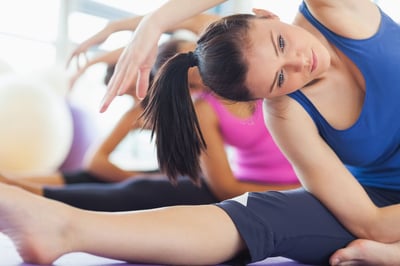The Benefits of Stretching and Why You Should Try Stretching Classes

I’m sure you have heard it before; you should stretch after your workout. Or before. Or both. Stretching has long been talked about as something we should do, but typically it is the first thing to get skipped when we are in a hurry. After this difficult year, stretching is coming back as a hot topic because of the much-needed mind and body benefits that stretching provides.
Benefits of Stretching
Research has shown that stretching can help improve both your body’s flexibility and mobility. Mobility is the range of motion of your joints. Flexibility is the ability of your muscles, tendons and ligaments to lengthen. For example, flexibility is being able to reach down and touch your toes. Your hamstring muscles must lengthen, or be flexible, in order for that toe reach to happen. An example of mobility is your ankle flexing so that you can lower into a squat. If your ankle won’t bend as much, you can’t go as low into a squat. Going back to the toe reach example, someone could have good hamstring flexibility but limited mobility at the hip joint keeping them from reaching their toes (or vice versa). Mobility and flexibility do sometimes go hand in hand, and the terms are sometimes used interchangeably, but they aren’t the same thing. What matters most is that you do need both in order to perform at your best.
Better flexibility and mobility can help to improve your performance in physical activities, reduce potential aches and pains, decrease your risk of injuries, and enable your muscles to work most effectively. Our everyday lives can lend to shortened muscles, especially after sitting for long periods of time. Shortened muscles, in turn, decrease range of motion and can trigger body aches and pains. Working out can leave our muscles shortened and feeling tight as well. Lengthening the muscles through static stretching after your workout can help your muscles recover from your workout and potentially leave you with less soreness. Stretching helps keep muscles long, healthy and strong.
Stretching should be part of every workout, and not just at the end. As ACE (American Council on Exercise) points out, “Dynamic stretches are often used as part of a warm-up to help increase core body temperature and functionally prepare the body for the movements that are to come. As a result, stretching is often considered an important part of injury prevention, as cold muscles and tendons in the body have a greater likelihood of rupture, strain or sprain.”
Stretching will help you stay active as you age. Improving mobility and maintaining flexibility (which naturally declines as we age) allows our body to stay in top shape. Maintaining flexibility while aging can decrease the risk of injury, improve balance, decrease chronic pain, improve workouts, improves posture and keeps you looking younger! The more we care for our bodies, the longer we can continue to be active and live independently.
Another benefit of stretching beyond flexibility and mobility is possible improvement in hypertension. According to research, when you stretch your muscles, you are also stretching all of the blood vessels that feed into the muscle. This includes your arteries. If you reduce the stiffness in your arteries, there is less resistance to blood flow which can result in a reduction in blood pressure.
Combine stretching with mindful breathing and it can help to reduce stress, tension, anxiety and depression.
Types of Stretches
Static Stretches: to extend a muscle group to its maximal point and holding it for 10-60 seconds. Static stretches can be either active or passive. In an active stretch added force is applied by the individual for greater intensity. Added force is added by an external force in a passive stretch.
Dynamic Stretching: unlike static stretching, dynamic stretches are continuous movements that usually mimic the exercise or sport to be performed. These types of stretches are usually done as a warmup.
Ballistic Stretching: this type of stretching isn’t frequently recommended. It utilizes repeated bouncing movement to stretch the targeted muscle group. The bouncing movements can trigger a stretch reflex and may cause a risk for injury, so they are not usually recommended without supervision from a Trainer.
Stretching Basics
It is important to stretch safely with proper technique. Stretching with improper form could do more harm than good.
Don’t do static stretching (when a stretch is held for 10-60 seconds) with cold muscles. Warm up with some light walking or another activity at a low intensity for 5 -10 minutes before doing any static stretching. Even better, stretch after your workout when your muscles are warm and the stretches will lengthen your worked muscles.
Instead of static stretching before your workout, complete a dynamic warmup with low intensity exercises like walking or dynamic stretches that could be completing similar movements to those in your upcoming workout but at a low level, then gradually increasing the speed and intensity as you warm up.
Dynamic stretching is great for joint mobility. A dynamic warmup features functional movements that move multiple joints through their full range of motion. This type of warm up can even include plyometrics (quick powerful movements) like hopping or jumping. Think jumping jacks or high knee skips. Other examples of great dynamic warm up moves are arm circles, squats, side leg swings and forward leg swings. Through your dynamic warm up, you are putting your joints through their full range of motion and getting your muscles warm because of an increased blood flow which makes your muscles and joints ready for more. This will help to keep proper form throughout your workout, as well as reduce the risk of injury and soreness after your workout.
Don’t lock your joints. Your arms and legs can be straight while stretching, but they shouldn’t be stiff, and your knees and elbows should not be locked.
Don’t bounce in your stretch. Bouncing as you stretch can injure your muscle and actually contribute to muscle tightness.
Watch for pain. You can expect to feel tension while you are stretching, but it shouldn’t be pain. Back off to the point that you don’t feel any pain, then hold the stretch.
Stretch regularly. You will get the most benefits if you stretch at least 2 – 3 times a week consistently.
Remember to breathe! Inhale right before you start the stretch and exhale as you relax your muscles and lean into the stretch. For static stretches, stay in the stretch for at least 30 seconds while breathing in and out normally.
Why Try Stretching Classes?
I don’t know about you, but I tend to rush through static stretching after my workouts, and I don’t do enough flexibility work on its own. It’s the first thing to go when in I’m in a rush. By taking a class specifically for stretching, it ensures each stretch will be held for the optimal time and that more stretching will be done. Also, having a professional lead you through a routine will ensure you will get a total body stretch.
Stretching can also be done with gentle movement, such as tai chi or yoga. But if those are not your favorite, don’t worry, they aren’t the only stretching classes. Many facilities are offering specific stretching classes that are geared to work on the muscle imbalances that can happen as a result of a sedentary lifestyle or that are an outcome from workouts. Other types of classes will focus more on the stress reduction benefits of stretching. Some stretching classes will blend the strengthening of muscles with stretches to improve balance, mobility, flexibility and strength. All with stress busting benefits as well.
With so many benefits to stretching, and so many options of classes to help to incorporate it into your routine, I hope you don’t skip this important part of keeping yourself healthy again.
Check out LivRite’s class schedule to find a class you love or work with a personal trainer to find the best stretches for your workout.
Topics: LivRite News, Stretching


